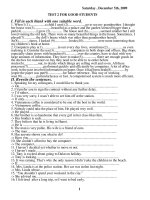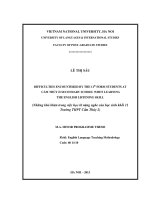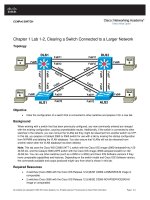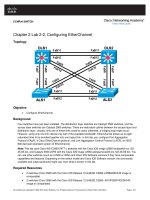CCNPv6 SWITCH lab2 2 etherchannel student
Bạn đang xem bản rút gọn của tài liệu. Xem và tải ngay bản đầy đủ của tài liệu tại đây (70.8 KB, 6 trang )
CCNPv6 SWITCH
Chapter 2 Lab 2-2, Configuring EtherChannel
Topology
Objective
•
Configure EtherChannel.
Background
Four switches have just been installed. The distribution layer switches are Catalyst 3560 switches, and the
access layer switches are Catalyst 2960 switches. There are redundant uplinks between the access layer and
distribution layer. Usually, only one of these links could be used; otherwise, a bridging loop might occur.
However, using only one link utilizes only half of the available bandwidth. EtherChannel allows up to eight
redundant links to be bundled together into one logical link. In this lab, you configure Port Aggregation
Protocol (PAgP), a Cisco EtherChannel protocol, and Link Aggregation Control Protocol (LACP), an IEEE
802.3ad open standard version of EtherChannel.
Note: This lab uses Cisco WS-C2960-24TT-L switches with the Cisco IOS image c2960-lanbasek9-mz.12246.SE.bin, and Catalyst 3560-24PS with the Cisco IOS image c3560-advipservicesk9-mz.122-46.SE.bin. You
can use other switches (such as a 2950 or 3550) and Cisco IOS Software versions if they have comparable
capabilities and features. Depending on the switch model and Cisco IOS Software version, the commands
available and output produced might vary from what is shown in this lab.
Required Resources
•
2 switches (Cisco 2960 with the Cisco IOS Release 12.2(46)SE C2960-LANBASEK9-M image or
comparable)
•
2 switches (Cisco 3560 with the Cisco IOS Release 12.2(46)SE C3560- ADVIPSERVICESK9-M
image or comparable)
All contents are Copyright © 1992–2010 Cisco Systems, Inc. All rights reserved. This document is Cisco Public Information.
Page 1 of 6
CCNPv6 SWITCH
•
Ethernet and console cables
Step 1: Prepare the switches for the lab.
Delete vlan.dat, erase the startup configuration, and reload all your switches. Refer to Lab 1-1, “Clearing a
Switch,” and Lab 1-2, “Clearing a Switch Connected to a Larger Network.”
Step 2: Configure basic switch parameters.
a. Assign each switch a hostname according to the topology diagram.
b. Configure ports Fa0/7 through Fa0/12 as trunks. On the 3560 switches, you must first set the trunk
encapsulation to 802.1Q. On the 2960s, only dot1q is supported, therefore the switchport trunk
encapsulation command is unavailable, but the mode still needs to be changed to trunk.
Note: If the ports are configured with dynamic auto mode and you do not set the mode of the ports to trunk,
the links do not form trunks and remain access ports. The default mode on a 3560 or 2960 switch is dynamic
auto. The default mode on a 3550 or 2950 switch is dynamic desirable.
DLS1 example:
DLS1# configure terminal
Enter configuration commands, one per line. End with CNTL/Z.
DLS1(config)# interface range fastEthernet 0/7 - 12
DLS1(config-if-range)# switchport trunk encapsulation dot1q
DLS1(config-if-range)# switchport mode trunk
Step 3: Configure an EtherChannel with Cisco PAgP.
Note: When configuring EtherChannels, it is a recommended best practice to shutdown the physical ports
being grouped on both devices before configuring them into channel groups. Otherwise, the EtherChannel
Misconfig Guard may place these ports into err-disabled state. The ports and port channel can be re-enabled
after the EtherChannel is configured.
a. The first EtherChannel created for this lab aggregates ports Fa0/11 and Fa0/12 between ALS1 and ALS2.
Make sure that you have a trunk link active for those two links with the show interfaces trunk command.
ALS1# show interfaces trunk
Port
Fa0/7
Fa0/8
Fa0/9
Fa0/10
Fa0/11
Fa0/12
Mode
on
on
on
on
on
on
Encapsulation
802.1q
802.1q
802.1q
802.1q
802.1q
802.1q
Status
trunking
trunking
trunking
trunking
trunking
trunking
Native vlan
1
1
1
1
1
1
<output omitted>
b. On both switches, add ports Fa0/11 and Fa0/12 to port channel 1 with the channel-group 1 mode
desirable command. The mode desirable option indicates that you want the switch to actively negotiate
to form a PAgP link.
ALS1(config)# interface range fastEthernet 0/11 - 12
ALS1(config-if-range)# channel-group 1 mode desirable
Creating a port-channel interface Port-channel 1
All contents are Copyright © 1992–2010 Cisco Systems, Inc. All rights reserved. This document is Cisco Public Information.
Page 2 of 6
CCNPv6 SWITCH
c.
Configure the logical interface to become a trunk by first entering the interface port-channel number
command and then the switchport mode trunk command. Add this configuration to both switches.
ALS1(config)# interface port-channel 1
ALS1(config-if)# switchport mode trunk
d. Verify that EtherChannel is working by issuing the show etherchannel summary command on both
switches. This command displays the type of EtherChannel, the ports utilized, and port states.
ALS1# show etherchannel summary
Flags: D - down
P - in port-channel
I - stand-alone s - suspended
H - Hot-standby (LACP only)
R - Layer3
S - Layer2
U - in use
f - failed to allocate aggregator
u - unsuitable for bundling
w - waiting to be aggregated
d - default port
Number of channel-groups in use: 1
Number of aggregators:
1
Group Port-channel Protocol
Ports
------+-------------+-----------+---------------------------------------1
Po1(SU)
PAgP
Fa0/11(P)
Fa0/12(P)
ALS2# show etherchannel summary
Flags: D - down
P - in port-channel
I - stand-alone s - suspended
H - Hot-standby (LACP only)
R - Layer3
S - Layer2
U - in use
f - failed to allocate aggregator
u - unsuitable for bundling
w - waiting to be aggregated
d - default port
Number of channel-groups in use: 1
Number of aggregators:
1
Group Port-channel Protocol
Ports
------+-------------+-----------+---------------------------------------1
Po1(SU)
PAgP
Fa0/11(P)
Fa0/12(P)
e. If the EtherChannel does not come up, you might want to try “flapping” the physical interfaces on both
ends of the EtherChannel. This involves using the shut command on those interfaces, followed by a no
shut command a few seconds later.
The show interfaces trunk and show spanning-tree commands also show the port channel as one
logical link.
ALS1# show interfaces trunk
Port
Fa0/7
Fa0/8
Fa0/9
Fa0/10
Po1
Mode
on
on
on
on
on
Encapsulation
802.1q
802.1q
802.1q
802.1q
802.1q
Status
trunking
trunking
trunking
trunking
trunking
Native vlan
1
1
1
1
1
All contents are Copyright © 1992–2010 Cisco Systems, Inc. All rights reserved. This document is Cisco Public Information.
Page 3 of 6
CCNPv6 SWITCH
<output omitted>
ALS1# show spanning-tree
VLAN0001
Spanning tree enabled protocol ieee
Root ID
Priority
32769
Address
0017.5a53.a380
Cost
19
Port
9 (FastEthernet0/9)
Hello Time
2 sec Max Age 20 sec
Bridge ID
Forward Delay 15 sec
Priority
32769 (priority 32768 sys-id-ext 1)
Address
001d.4635.0c80
Hello Time
2 sec Max Age 20 sec Forward Delay 15 sec
Aging Time 300
Interface
Role Sts Cost
Prio.Nbr Type
------------------- ---- --- --------- -------- ---------------------------Fa0/7
Fa0/8
Fa0/9
Fa0/10
Po1
Altn
Altn
Root
Altn
Desg
BLK
BLK
FWD
BLK
FWD
19
19
19
19
12
128.7
128.8
128.9
128.10
128.56
P2p
P2p
P2p
P2p
P2p
Step 4: Configure an 802.3ad LACP EtherChannel.
a. In 2000, the IEEE passed 802.3ad, which is an open standard version of EtherChannel. Using the
previous commands, configure the link between DLS1 and ALS1 on ports Fa0/7 and Fa0/8 as an LACP
EtherChannel. You must use a different port channel number on ALS1 than 1, because you already used
that in the previous step. To configure a port channel as LACP, use the interface-level command
channel-group number mode active. Active mode indicates that the switch actively tries to negotiate
that link as LACP, as opposed to PAgP.
ALS1(config)# interface range fastEthernet 0/7 - 8
ALS1(config-if-range)# channel-group 2 mode active
Creating a port-channel interface Port-channel 2
ALS1(config-if-range)# interface port-channel 2
ALS1(config-if)# switchport mode trunk
b. Apply a similar configuration on DLS1. Verify the configuration with the show etherchannel summary
command.
ALS1# show etherchannel summary
Flags: D - down
P - in port-channel
I - stand-alone s - suspended
H - Hot-standby (LACP only)
R - Layer3
S - Layer2
U - in use
f - failed to allocate aggregator
u - unsuitable for bundling
w - waiting to be aggregated
d - default port
Number of channel-groups in use: 2
Number of aggregators:
2
All contents are Copyright © 1992–2010 Cisco Systems, Inc. All rights reserved. This document is Cisco Public Information.
Page 4 of 6
CCNPv6 SWITCH
Group Port-channel Protocol
Ports
------+-------------+-----------+---------------------------------------1
Po1(SU)
PAgP
Fa0/11(P)
Fa0/12(P)
2
Po2(SU)
LACP
Fa0/7(P)
Fa0/8(P)
Step 5: Configure a Layer 3 EtherChannel.
In the previous steps, you configured EtherChannels as Layer 2 trunk connections between switches. You
can also configure EtherChannels as Layer 3 (routed) connections on switches that support routed ports.
Because DLS1 and DLS2 are both multilayer switches, they can support routed ports.
a. Use the no switchport command on Fa0/11 and Fa0/12 to make them Layer 3 ports, and then add them
to the channel group with the channel-group number mode desirable command. On the logical
interface, issue the no switchport command to make it a Layer 3 port. Add the IP address 10.0.0.1 for
DLS1 and 10.0.0.2 for DLS2. Configure both with a /24 subnet mask.
DLS1(config)# interface range fastEthernet 0/11 - 12
DLS1(config-if-range)# no switchport
DLS1(config-if-range)# channel-group 3 mode desirable
Creating a port-channel interface Port-channel 3
DLS1(config-if-range)# interface port-channel 3
DLS1(config-if)# no switchport
DLS1(config-if)# ip address 10.0.0.1 255.255.255.0
b. Verify that you have Layer 3 connectivity by attempting to ping the other side of the link.
DLS1# ping 10.0.0.2
Type escape sequence to abort.
Sending 5, 100-byte ICMP Echos to 10.0.0.2, timeout is 2 seconds:
!!!!!
Success rate is 100 percent (5/5), round-trip min/avg/max = 1/1/1 ms
c.
If you look at the output of the show etherchannel summary command, you see that it lists the port
channel as a routed port, not a switched port. The RU in parentheses next to the name means routed and
up, as opposed to switched and up (SU).
DLS1# show etherchannel summary
Flags: D - down
P - in port-channel
I - stand-alone s - suspended
H - Hot-standby (LACP only)
R - Layer3
S - Layer2
U - in use
f - failed to allocate aggregator
u - unsuitable for bundling
w - waiting to be aggregated
d - default port
Number of channel-groups in use: 2
Number of aggregators:
2
Group Port-channel Protocol
Ports
------+-------------+-----------+---------------------------------------2
Po2(SU)
LACP
Fa0/7(P)
Fa0/8(P)
3
Po3(RU)
PAgP
Fa0/11(P)
Fa0/12(P)
All contents are Copyright © 1992–2010 Cisco Systems, Inc. All rights reserved. This document is Cisco Public Information.
Page 5 of 6
CCNPv6 SWITCH
Step 6: Configure load balancing.
The switches can use different methods to load-balance traffic going through a port channel. The available
methods as well as the default method used varies by hardware platform. By default, Cisco Catalyst 3560 and
Catalyst 2960 switches load-balance using the source MAC address.
a. You can view the current load-balancing configuration with the show etherchannel load-balance
command.
DLS1# show etherchannel load-balance
EtherChannel Load-Balancing Operational State (src-mac):
Non-IP: Source MAC address
IPv4: Source MAC address
IPv6: Source IP address
Other methods of load balancing are based on the destination MAC address, both source and destination
MAC addresses, source IP address, destination IP address, and both source and destination IP
addresses. Some older platforms, such as the Cisco Catalyst 2950 and Catalyst 3550 switches, may not
support all of these methods.
b. For this scenario, configure ALS1 to load-balance by both source and destination MAC addresses using
the global configuration command port-channel load-balance method, where the method is src-dstmac.
ALS1(config)# port-channel load-balance src-dst-mac
c.
Verify the configuration with the show etherchannel load-balance command.
ALS1# show etherchannel load-balance
EtherChannel Load-Balancing Operational State (src-dst-mac):
Non-IP: Source XOR Destination MAC address
IPv4: Source XOR Destination MAC address
IPv6: Source XOR Destination IP address
Challenge
The topology still has redundant links that you can aggregate. Experiment with the other port channel modes
using the question mark on the interface-level command channel-group number mode ?. Look at the
descriptions and implement some port channels in different ways. If The port mode is set to desirable, auto,
active or passive (when PAgP or LACP are used), the command channel-protocol can be used. It cannot be
used with channel-group number mode on command. The “on” mode statically sets the EtherChannel
protocol without negotiation.
All contents are Copyright © 1992–2010 Cisco Systems, Inc. All rights reserved. This document is Cisco Public Information.
Page 6 of 6
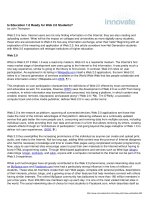
![moodle 2 for teaching 7-14 year olds [electronic resource] beginner's guide effective e-learning for younger students, using moodle as your classroom assistant](https://media.store123doc.com/images/document/14/y/rn/medium_rni1401360130.jpg)

